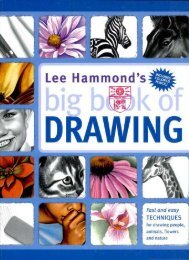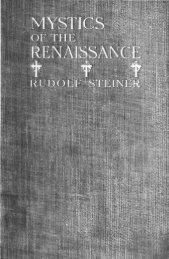The Supreme Doctrine - neo-alchemist
The Supreme Doctrine - neo-alchemist
The Supreme Doctrine - neo-alchemist
You also want an ePaper? Increase the reach of your titles
YUMPU automatically turns print PDFs into web optimized ePapers that Google loves.
THE HORSEMAN AND THE HORSE<br />
separated by no hiatus. We are centaurs but everything happens in us as<br />
though we were horse and rider because we believe in the reality of a hiatus<br />
between our two aspects, or, more exactly, because we do not see the unity in<br />
which the two aspects are integrated.<br />
We will try to define, in our concrete structure, what we see as horse<br />
and as rider, and to understand why we have this false vision of ourselves.<br />
We are first of all tempted to trace the boundary between the horse and<br />
the rider starting from a morphological standpoint: the horse would be our<br />
gross manifestation, or soma, the rider our subtle or psychic manifestation.<br />
But this morphological point of view does not suit the angle from<br />
which we are studying man at this moment. We are studying, at this moment,<br />
not only the modalities of the functioning of the human machine, but the<br />
problem of the determination of this functioning. Going beyond the<br />
consideration 'how our life works' we are studying the orientation of this<br />
working. Looked at from this higher perspective, the two parts of man are no<br />
longer two modalities of phenomena, some physiological the others<br />
psychological, but two ways of being, two styles, two different rhythms of<br />
the manifestation of our being.<br />
<strong>The</strong> horse represents my way of being when my thought does not<br />
function in an independent, impartial manner. It is my personal life, egotist<br />
and partial, that which I live when my intellect works geared to my desires,<br />
my fears, my affective reactions in general. It is my life when there operates<br />
in me only the inferior conciliatory principle, the Demiurge who rules over<br />
the metabolism of the temporal plane. It is Nature willing herself in me,<br />
achieving her ends through my organism. It is I in so far as I wish to be<br />
distinct, in so far as I wish to be Self beside, and opposed to, the Not-Self.<br />
<strong>The</strong> rider represents my way of being when my thought, ungeared from<br />
my affective life, works in an independent, impartial manner. It represents<br />
my Independent Intelligence, impartial reason, or pure, objective, or universal<br />
thought. It is I in so far as I think without wishing to be distinct, outside all<br />
opposition between the Self and the Not-Self.<br />
<strong>The</strong> rider, understood in this sense, is not a motive-power. It is the<br />
principle of direction in the movement of my machine, but it is not the motor.<br />
It is the principle of my 'acting', itself 'non-acting'. In consequence, if the<br />
horse and the rider are two ways of being, the horse alone is a way of living;<br />
the rider is not a way of living—since living implies movement and the rider<br />
is 'non-acting'—it is a way of thinking that is independent of my life. In my<br />
156




